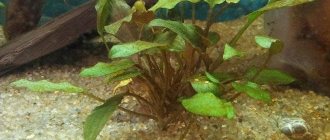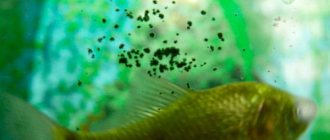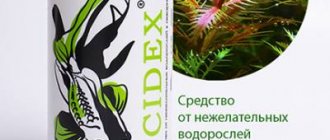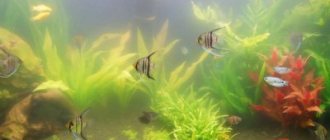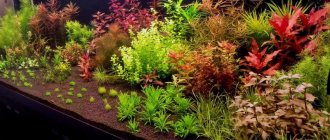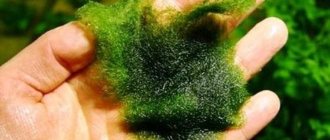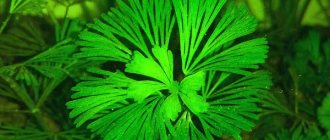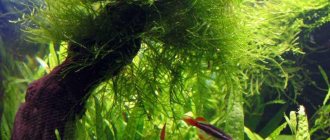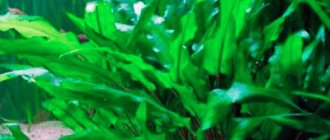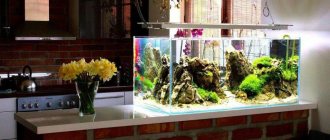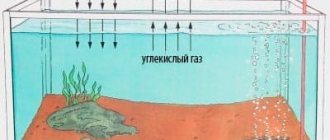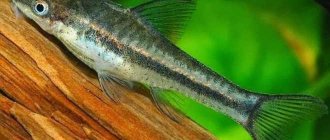How to recognize thread
The algae is thin threads from light green to black. They attach to any surface, but retain their shape only under water. If you take the thread to the surface, it will sag, and with physical impact it easily disintegrates. Aquarium plants are primarily affected, especially specimens with small dissected leaves. It seems that their tops are entwined with cobwebs or shrouded
Filamentum is easily confused with cladophora, since both algae resemble balls of thread. The difference is that the first one is easily destroyed, while the second one is tougher and stronger.
The reason for the appearance of algae is a violation of the microflora and the balance of nutrients (nitrogen, potassium, phosphorus) in the aquarium. Filament loves bright light, uneven supply of carbon dioxide, excess ammonia, organic waste and leftover fish food.
Why is filamentous algae dangerous?
Filamentous algae are different accumulations of fairly long or short filaments. Separate bunches can be formed from them; thin algae are perfectly attached to driftwood, entangling higher aquarium plants, filter tubes and other equipment. The color of such algae is most often green, but protozoa can also be found with brown, black, gray and even reddish colors. A small amount of filamentous algae is considered normal and rather indicates that the breeding conditions in the aquarium are suitable for other plants. But a huge number of filamentous growths can bring a lot of problems, and these, first of all, include:
- The release of toxic substances from algae residues that have a detrimental effect on the inhabitants of the aquarium. The natural death of a large number of filamentous algae leads to a continuous process of decomposition, which results in the release of toxins.
- Threads of algae entangle plants growing in the aquarium and thereby interfere with their growth and development.
- Residues of food and other organic substances are retained on the algae, and this leads to rapid contamination of all the water in the aquarium.
- Small fish and fry can become entangled in tufts of filamentous algae.
In connection with these problems, it is always necessary to combat rapidly growing filamentous algae in an aquarium, and both the simplest methods and certain professional techniques can help with this.
How to destroy filament forever
To destroy filamentous weeds, an integrated approach is required. Mechanical cleaning methods are combined with the use of chemicals and natural enemies of algae.
Mechanical cleaning of the aquarium
Pros:
- simplicity and low cost - for mechanical cleaning there is no need to buy additional devices.
Minuses:
- the method cannot completely get rid of the filamentous algae - if improperly cared for and under favorable conditions, the algae will appear again.
Cleaning the aquarium from filament is carried out by hand or with any convenient device. The threads are easily wound onto toothpicks, wooden sticks, and toothbrushes. It is especially convenient to use electric ones - they allow you to clean plants and accessories without removing them from the tank.
You can scrape algae from glass using an old plastic card, bank or store card - plastic does not scratch glass and does its job well. Residues that have fallen to the bottom are removed with a net or filter.
Chemicals
Pros:
- drugs to combat filamentous fungus act quickly, completely destroy the parasite, and some of them can be used for preventive purposes.
Minuses:
- the products are not cheap, they can harm plants and fish, and when working with them you should be careful (protect your hands and mucous membranes).
Hydrogen peroxide
Sidex
The classic remedies against thread are hydrogen peroxide and the cleaning agent Sidex.
The dosage is determined depending on the scale of the problem:
- average overgrowth – 12-15 ml/100 l of water;
- severe infection - 20-30 ml/100 l of water;
- prevention – 7.5 ml/100 l of water.
The liquid is dissolved in a small amount of water and poured evenly into the aquarium. If necessary, treatment can be repeated after 1-2 weeks.
Hydrogen peroxide and Sidex are considered radical control methods, so they should be used with caution, after first removing sensitive aquarium inhabitants. More gentle means are preparations containing algaecides, which destroy the structure of algae and prevent its reproduction.
Tetra AlgoStop depot
(Monolinuron) The drug is available in the form of tablets; to combat threadworm, you need to use 1 tablet per 20 liters of water. The substance is released slowly, the concentration is constantly maintained, the procedure can be repeated after 4 weeks
AQUAYER AlgoShock
(Hydrogen peroxide, algaecide QAC) The dosage of the product is 8 ml per 50 liters of water per day, treatment should be carried out for three days in a row. If there is a large amount of algae, the dose can be increased to 12 ml per 50 liters
Tetra AlguMin Plus
(Monolinuron) Add 5 ml of the drug per 10 liters of water, after shaking the liquid, if necessary, repeat the procedure after 3-4 weeks. The preventive dose is 5 ml per 20 liters of water
When used correctly, the products are harmless to fish and plants. If the infestation of the aquarium with filament is large-scale and the dose needs to be increased, it is better to remove the living inhabitants. In large doses, monolinuron and other active ingredients can be toxic to them.
If the filament grows in small groups, liquid preparations are used pointwise. To do this, you need to turn off filters, aeration and other devices so that the movement of water in the aquarium stops. Take a syringe with a thin needle, draw the product into it and slowly, so that the liquid does not mix with water, apply the drug to the areas where the algae grows. After the procedure, leave the aquarium for half an hour.
Filament in the aquarium
Filament is a real disaster for both beginners and experienced aquarists. Despite the fact that you can find countless information about filament on the Internet, many people struggle with this problem for months, often without success. If attempts to improve the situation do not bring results, you need to study the issue more globally.
What is filament, its main differences from other types of algae
What is filamentous algae and how can it be distinguished from other types of algae? Filamentous algae are parasitic algae that attach to plants. They have a thread-like shape (from which they get their name) and are light green in color.
The structure of the threads is very soft and delicate. To make sure that it is filament in the aquarium, you need to feel it: it feels mucus, the threads are easily rubbed with your fingers, and if you pull them out of the water, the shape is immediately lost and the threads sag.
You don’t need to think that all filamentous algae are called filamentous algae, because if you take cladophora, Vietnamese or blackbeard, the difference is immediately visible. These algae have tough threads and it is quite difficult to tear them off from the plant. Cells of the filamentous algae type are connected into a thread, the shape of which can be simple or branched.
They reproduce vegetatively, by filament disintegration. Floating in the water column, the fragments attach to the substrate, which makes it possible to quickly occupy territory.
If we talk exclusively about filamentous fish, then the aquarium is most often inhabited by 3 species:
- edogonium;
- spirogyra;
- Rhizoclonium.
Why is the appearance of algae dangerous for an aquarium?
It is impossible to keep both algae and plants in peaceful coexistence at the same time; they will certainly compete for territory.
Growing on the leaves of plants, the filament is parasitic. Over time, it envelops the plant so much that light and nutrients do not reach it, plant growth is inhibited, and they die.
For fish, algae generally pose no threat, but this is only at first. The fact is that when a plant dies, its leaves fall off and begin to decompose, and the same happens with dead algae cells. The bio-balance of the aquarium cannot cope with waste; the water becomes saturated with toxic substances, which is detrimental to all inhabitants of the aquarium.
Also interesting: Guppy reproduction
Even from an aesthetic point of view, algae in a home pond does not create the best appearance, especially when watching expensive plants die.
Reasons for the appearance of filamentous algae in an aquarium
An aquarium is a small copy of a natural reservoir at home with a similar ecosystem, designed to contain various aquatic inhabitants and plants. For an ecosystem to function properly, many things need to be taken into account.
For example: Do not turn an aquarium into a dormitory. Each type of fish requires a certain number of liters of water.
Organize a sufficient amount of vegetation. Plants and underwater inhabitants live in symbiosis. Fish provide food to the plants, which in turn purify the water and produce oxygen. The more inhabitants in a small space, the more difficult it will be for plants to process ammonia and ammonium, growth will begin to be inhibited, they will gradually weaken and become vulnerable to the attachment of filament.
Intervene as little as possible in the created habitat. In a normally running tank, colonies of bacteria settle, which are necessary for the normal functioning of the aquarium. If the aquatic environment is continuously disturbed, the bacteria will die and the ecosystem will be shaken, causing harm to both fish and plants. An environment with a low number of bacteria has the greatest likelihood of unwanted parasites appearing.
Organize aeration supply and water filtration appropriate to the tank.
Don't forget to make substitutions.
Optimal lighting.
If any point is not observed, the ecosystem will be disrupted. The likelihood of threads appearing is lowest in a healthy aquarium. Spores can appear in the aquarium during water changes in the summer (water pipes from the inside can become overgrown with algae) or accidentally brought in from a pet store.
Types of thread, ways to combat it
You need to understand that to improve the situation, the first step is to solve the cause that led to this problem. Only by eliminating the cause can you cope with an outbreak of algae growth. If this is not done, after a while the jar will begin to turn into mud again.
Rhizoclonium
Rhizoclonium appears 2–3 weeks after the aquarium is not started properly. Often, due to inexperience, novice aquarists stock fish and plants in fresh, unsettled water. Colonies of beneficial bacteria do not have time to settle and begin to function normally.
Also interesting: The aquarium is leaking
There will be no one to process fish waste and, accordingly, the level of ammonia, ammonium and phosphate will increase. Plants are unable to process their excess. Then their growth slows down, their health weakens, the leaves begin to separate and rot, which further increases ammonia and ammonium. For an outbreak of rhizoclonium, all that is needed is an unsettled nitrogen cycle and excess ammonium.
When the nitrogen cycle is restored, Rhizoclonium leaves on its own. A 50:50 water change per week is required (to reduce the amount of ammonium). If desired, you can use the drug Algicide + CO2, although there is no urgent need for it.
Edogonium
This species appears in the form of a fluff, and only on the most weakened plants. For normal life of vegetation, phosphates and nitrates must be present in the water in normal quantities, but if they are not enough, edogonium joins the leaves.
For a successful fight at the initial stage of development of this type of filament, you need to add macroelements - literally in a week the plants will become healthier and the algae will disappear. In the absence of macroelements, edogonium grows rapidly. Then you will have to resort to the help of the drug AlgoShok.
Spirogyra
One of the most resilient algae. It is very difficult to get rid of, despite the fact that spirogyra is very fragile and delicate. It is known that algae and plants compete with each other, and when one begins to dominate, the second dies. In this case, spirogyra lives even in a healthy reservoir on healthy plants, so it is impossible to do without medications.
AlgoShock is one of the main drugs in the fight against spirogyra and various algae. During treatment, you must additionally manually remove fouling from the aquarium:
regularly remove growths from affected areas;
When the remaining algae sinks to the bottom, they need to be siphoned off.
As an additional means of combating filament, you can keep fish that eat algae: Siamese algae eaters, ancistrus, mollies, and shrimp. At the same time, it is advisable to reduce lighting and increase the water temperature to slow down their growth.
Category: Aquarium fish
Natural enemies
Pros:
- Controlling algae using natural pests is a safe and gentle way.
Minuses:
- shrimp and fish that eat filament require special housing conditions and may not get along with the existing inhabitants of the aquarium.
Filamentous algae is a soft algae, so it is happily eaten by Amano shrimp, barbs, and neretina snails. It will be difficult for them to cope with a large-scale algae infestation, but they will destroy a small amount of the parasite quickly and with great appetite.
Barbs
These brightly colored fish must be kept in schools - at least 6 pieces in an aquarium with a volume of at least 60 liters. The water must be clean (a filter and compressor are required), the temperature must be 20-25 degrees. Barbs get along well with most fish, except for large predators and specimens with veil fins.
In the first case, they can become a victim, in the second, they can bite the fins of their neighbors. For the same reason, you should not allow barbs into an aquarium where there are plants with small, delicate leaves.
Amano shrimp
They owe their popularity to the most famous aquascaper Takashi Amano. Shrimp are kept in groups of 10 or more, and to combat threadworms it is better to choose large specimens. If the content of nitrogenous compounds in the water is high, they may die, so care should be taken about filtration and aeration. Amano get along well with any neighbors, with the exception of too large fish and predators that can feast on shrimp.
Neretina
Unpretentious snails with a beautiful yellowish-black shell. Neretinas love spacious containers with good filtration, aeration and moderate hardness. They feed on algae and organic debris, and rarely require additional nutrition.
Do not forget about the important feature of the natural enemies of filament. Well-fed fish, shrimp and snails will not eat algae, so they are not fed for several days before being introduced into the aquarium. After the parasite is destroyed, barbs, Amano shrimp and neretins can be kept to prevent the proliferation of filamentous shrimp. They do not require serious care and diversify the fauna of the aquarium well.
Coil snails are considered the most effective helpers in the fight against algae, but they often die immediately after being introduced into the aquarium. This is due to the fact that neretins do not tolerate sudden changes in water parameters. You need to launch the snails carefully, with the mouth down, as it is difficult for them to turn over on their own.
Methods of fighting and getting rid of aquarium algae
For all types of algae, the manual removal method is relevant:
- collect weeds with your hands;
- wipe the glass;
- walk the siphon along the ground;
- wash the decorations;
- change some of the water.
Further, algae control is carried out using different methods:
- adjusting the light;
- planting higher plants;
- introduction of chemicals.
Remember that it is not enough to simply destroy the lower vegetation; it is necessary to eliminate the cause of the abundant growth.
Reducing lighting in an artificial pond
Darkening the aquarium is effective against Xenococus, Spirogyra, Euglena and blue-green cyanobacteria. Do not turn on the light for 2-3 days, darken the aquarium by throwing a cloth over the top. If there are light-loving plants in the pond, temporarily transplant them into another container with the required level of light. Do not turn off the aeration, because algae absorb oxygen. After exposure, remove dead flora and change the water. Use this method in conjunction with introducing algae-eating animals.
Application of fast-growing vegetation
Grasses crowd out lower greens, consuming all the nutrients from the environment. The method is effective against green and red algae. After exposure, the plants can be removed from the aquarium. Fast growing ones include:
- elodea;
- hornwort;
- cabomba;
- nayas;
- hygrophiles;
- lemongrass
Using algae-eating fish
Introduce pets that eat lower flora in combination with other control measures. Beneficial animals include:
- Siamese algae eater. Eats filamentous algae, xenococus and diamatous algae. He eats “flip-flop” and “blackbeard” less often if there is no other food.
- Malawian cichlids. They eat blackbeard, but can also eat higher plants.
- Catfish (Ancistrus, Otocinclus, Plecostomus). They are good at fighting brown and green algae, but sometimes they don’t mind eating the delicate leaves of anubias and lemongrass.
- Snails (horned snails, ampullaria, marises, coils, neretina). They eat brown and filamentous algae, including the difficult-to-breed spirogyra.
- Viviparous fish (guppies, swordtails, mollies, platies). Copes with green and brown growths.
- Amano shrimp are helpers in the fight against threadworm.
Chemical methods
Administer medications when other methods are ineffective. Chemicals negatively affect the biological balance of the aquarium. It is optimal to use special-purpose drugs whose name contains the word algo (algae). Household products like hydrogen peroxide and bleach will also work.
Carbon dioxide
The supply of carbon dioxide together with good lighting creates an unfavorable environment for lower plants. To combat algae, gradually increase the carbon dioxide content in the aquarium using homemade or purchased devices.
Hydrogen peroxide
Peroxide is sufficient in a concentration of up to 2.5 ml per 10 liters of water. Apply the solution pointwise to clusters of weeds, increasing aeration for the duration of exposure. If your fish become hypoxic, replace some of the water immediately. Peroxide kills cyanobacteria, blackbeard, euglena and Vietnamese. To remove parasites from leaves, soak the plants separately in a bath with a concentration of 4 ml of peroxide per 10 liters of water. After exposure, change 20-25% of the water.
Chlorine
Flora and fauna are susceptible to chlorine in different ways. Dilute chlorine in 30–40 parts of water. Take a twig or leaf on which algae has grown and lower it into the solution. If the greens turn white, dilute the preparation with water. While maintaining the natural color, add the solution to the aquarium gradually. Use once. Powerful aeration, water changes and removal of dead algae are required.
Nutrients
Reduce the amount of fertilizer applied, then algae growth will be sharply reduced. Change the water and add fast-growing plants to absorb excess nutrients.
Glutaraldehyde
Preparations and solutions containing glutaraldehyde are effective against green, filamentous and red algae. The solutions are used in herbal medicine and are safe for many plants. Use in a concentration of up to 12 ml per 100 liters of water. Apply the solution in the morning for a week.
Blackout
Pros:
- the method destroys not only filamentous algae, but also other types of algae, leaving them practically no chance.
Minuses:
- darkening can kill aquarium plants, especially those that require good lighting.
Darkening the aquarium is used by many experienced aquascapers.
Before the procedure you must:
- Remove as much algae as possible mechanically.
- Trim overgrown plant leaves.
- Siphon the aquarium, clean the filter, change the water by 50-70%.
- Turn off the lights and carbon dioxide supply.
- Turn on filtration and completely darken the aquarium.
- In case of severe infestation, you can add a product containing an algaecide and then wait three days.
During this time, the algae will die, but the plants and living inhabitants will remain unharmed. The aquarium is fully launched on the fourth day. If there is too much dead algae in the tank, they should be removed with a net and the filter should be rinsed thoroughly to prevent the release of ammonium. Turn on the lighting and CO2 supply - first to a minimum, then gradually increase over several days. To restore normal plant growth, add nitrogen and phosphorus.
Ruslan Ivanyushin (aka naman)
Russian aquascaper
Filamentous hair was once thought to be caused by high iron levels, but this is not true. If you reduce the dose of the microelement to 0.1 mg/l, the algae will not die, but the plants will begin to experience chlorosis, a disease associated with Fe deficiency, from which they will stop growing.
Tom Barr's advice
Renowned aquascaper Tom Barr has conducted many experiments related to water parameters that are ideal for plants, but do not provoke algae.
They look like this:
- Fe (iron) – 0.5 mg/l.
- NO3 (nitrates) – 5-20 mg/l;
- K (potassium) – 10-30 mg/l;
- PO4 (phosphate) – 0.4-1.5 mg/l;
- CO2 (carbon dioxide) – 20-30 mg/l;
Tom Barr recommends doing at least 50% water changes weekly. They help maintain normal nutrient concentrations and eliminate the risk of overdose. Recommended lighting, under which almost all plants can grow, is broad-spectrum fluorescent lamps with a power of 0.5 W/l.
The aquascaper claims that in 95% of cases the cause of the appearance of algae in the aquarium is a low concentration of CO2 and a lack of nitrates, and you need to focus not on tests, but on the condition of the plants.
Filamentum can be destroyed using chemicals or natural enemies, but do not forget about maintaining normal microflora in the aquarium. Under favorable conditions, the secondary appearance of algae will not be long in coming, even if the first time you had to completely get rid of it.
